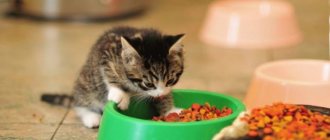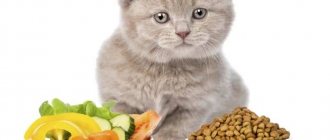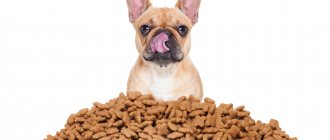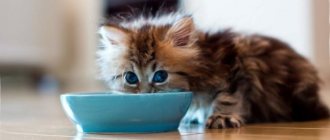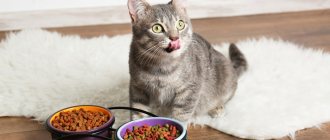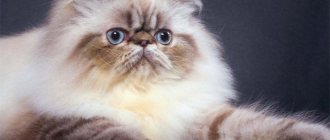Is it possible to feed dry food and natural food at the same time?
A varied diet is important for cats ; this does not mean that a small predator needs delicacies. Under natural conditions, representatives of the cat family eat certain foods throughout their lives. The main thing is that food serves as a source of nutrients in the right proportion.
A pet cannot choose its own food ; the owner must decide what type of food is suitable for the animal. Dry pads are preferable to food from a person's table. But natural products (meat, milk, fish, vegetables), prepared taking into account the cat’s needs, will bring tangible benefits to the body.
Doctors do not recommend feeding industrial food and natural food at the same time. A mixed type of feeding will lead to imbalance, indigestion, gastritis, and colitis. The animal's metabolism will be disrupted.
Can a kitten refuse dry food?
This is possible, but not at all because, as some believe, the animals feel that such food is not suitable for them. It’s just that, most likely, the kitten is not accustomed to dry food and it will take some time for him to get used to this product. To facilitate the training process, soaking is practiced, and read about how to do this here.
Refusal is also possible if the kitten was previously fed natural products or wet food, and then he will also need to be switched to dry food for a certain period of time. For the rules of this transfer, read the article “How to transfer a kitten to dry food?”
When introducing a new diet, it is very important to monitor your pet’s well-being and stool, because even the highest quality food, like any other food, may not be suitable specifically for your kitten.
What is the best food for a cat?
Complete food in the form of dry food is designed specifically to ensure that the cat receives all the necessary substances, vitamins and microelements. So if you feed the animal something else, you can create an imbalance in the body. It is often difficult for owners to calculate how much protein, fat, carbohydrates and other substances a cat needs, and if you feed the animal thoughtlessly, you can cause a deficiency or excessive content of any substance in the cat’s body. That is why you should not experiment with mixed food, but give your beloved pet high-quality and balanced dry food, which will undoubtedly be beneficial and your cat will like it.
Diet including only dry food
If the owner, when choosing dry food for his cat, gives preference to a high-quality, expensive manufacturer, then feeding only one type of food is possible. Such products contain all the substances necessary for the cat’s body, including proteins, fats, carbohydrates, vitamins and minerals.
© shutterstock
When preparing a diet based on “drying”, it is not recommended to feed the cat anything else. Since the types of nutrition when feeding dry food and, for example, meat, which the owner decided to pamper the cat with, differ, the animal’s body needs to adapt from one type to another. If this procedure occurs frequently, it will be very difficult for the cat’s digestive system and overload will occur.
Also, any additions of natural food will upset the balance of substances beneficial to the body. Oversaturation will occur since good quality cat food already contains all the necessary substances. But despite this, some breeders use a mixed type of nutrition, including both dry and natural food.
If you follow the recommendation of a veterinarian, then you need to feed your cat with one of two types of food. And if it is drying, then you need to use it correctly, i.e. Feed the kitten only dry food.
Is it possible to feed a kitten this way?
In some cases, an adult animal can be given two types of food, dividing the intake by time. It is strictly forbidden to feed a kitten with natural food if the baby is accustomed to specialized canned food from birth.
Be sure to read: 4 methods on how to switch a cat from dry food to homemade food A gradual transition to natural food is possible from the age of two months.
How to switch a cat to dry food
If it is necessary to transfer an adult animal to drying, you should first make sure that the pet is healthy and goes to the litter box properly.
It is not recommended to administer dry food to pregnant and lactating females, sick, elderly animals, as well as cats with chronic problems with the kidneys and urinary tract. If a cat is naturally inclined to drink little water, then dry food is also contraindicated for her.
The translation is carried out gradually. At the first stage, 10-15 soaked dry food granules are added to the cat's regular food. In subsequent days, the amount of soaked dry food should increase, and the proportion of regular food should decrease proportionally. The food needs to be soaked until it is mixed with regular food. This is done in order to facilitate the joint digestion of the components. In this case, you need to watch how the pet behaves. Cats usually eat food willingly. If the pet expresses obvious displeasure, then you can try products from another manufacturer. If you have problems with the coat or digestive system, you should contact your veterinarian.
In most cases, healthy cats readily eat high-quality dry food.
How many times to feed...
If a cat is accustomed to a routine, she will quickly get used to the fact that food appears in her bowl at exactly the scheduled time. In this case, one of the most unpleasant problems - begging near the table - will disappear. How many times to feed your cat dry food depends on the age of the pet and its condition.
Table - Number of pet feedings
| Pet age | Number of receptions, times |
| Kittens up to 6 months | 3 |
| Pets from 6 to 8-9 months (before sterilization or castration) | 2-3 |
| Neutered cats | 1-2 |
| Neutered cats | 2 |
| Pregnant cats | 3 |
| Nursing cats | 3-4 |
| Elderly pets | 1 |
Is it possible to feed a cat only dry food?
Many cat owners doubt that their pets can only be fed dry food. In fact, it is not only safe, but also healthy, because the finished diet contains all the necessary nutrients. However, this is only true if the cat owner purchases super-premium or holistic food. They contain high-quality meat ingredients without excess herbal additives. A good ready-made diet prevents the development of chronic diseases thanks to a complex of preventive components and maintains the optimal condition of internal organs.
It is not only possible, but also necessary to feed a cat only dry food. Pets are conservative. They get used to a stable daily routine, feeding schedule and chemical composition of food. Any deviation can provoke a disorder in the gastrointestinal tract. For example, my sister once fed my cat chicken liver. She thought that the animal must be sad to constantly eat only pellets. Despite the fact that the cat was once on a natural diet, after that he had diarrhea. The condition returned to normal immediately after returning to the usual regimen.
When choosing dry food, it is better to give preference to darker granules: they contain more meat
Cats should not be fed dry food unless they have special needs and individual characteristics. For example, it is better to give pouches, pates or natural products to animals that do not comply with the drinking regime. Ideally, your pet should consume 3 times more water than food. The norm may vary, but the volume should be at least 20–30 ml per day. Some cats with sensitive digestion are not suitable for dry food due to its texture: it provokes internal bleeding and causes inflammation.
You should not feed cats cheap dry food. Economy and premium class products are prohibited. They contain insufficient nutrients, which sooner or later will inevitably provoke the development of pathologies. In most cases, the disease progresses quietly and slowly, so until the first exacerbation the owner does not even suspect there is a problem. When deviations make themselves felt, the moment for treatment may already be missed. The same applies to dry food, which is not a complete food: treats are not suitable for systematic nutrition, since they are not able to provide the cat’s body with all the nutrients required for proper functioning.
When do you need to change the type or diet of feeding?
Restrictions:
- It is prohibited to introduce dry food and homemade food into your pet’s diet.
- You cannot feed raw and boiled foods at the same time.
It should be noted that premium industrial food contains a sufficient amount of useful substances: necessary for the full development of a small predator. Adding natural food to the diet can cause disruption in the animal’s body.
The combined use of two types of products is allowed only when changing the diet.
A change in diet is necessary if:
- the animal ages, matures;
- the pet has been diagnosed with a chronic disease;
- castration or sterilization surgery awaits;
- food allergy detected.
The change in diet should be gradual, new food should be introduced in small portions, gradually completely removing the previous food from the diet. The cat is transferred to a new diet within 20-25 days.
It is forbidden to treat your cat with pieces “from the table”. Food is given out in several stages. One stage is natural food, the second stage is dry pads, the share of new food increases every day. Food bowls should be removed as soon as the animal has eaten.
Is it possible to feed only dry food?
Dry food with its appearance in one fell swoop eliminated the problem of a balanced diet for domestic cats. Initially, this is a complete diet that can satisfy the need for the most important elements. Proteins, fats, carbohydrates, vitamins, in general, are what the cat’s body needs. The list is actually long.
Dry food, containing what is necessary, does not require any additions for the cat. It is suitable as a main dish in a mono-diet. Veterinarians are not against combining dry food and other types of food, but they recommend giving cats one thing at a time. That is, there is no need to doubt: a cat can only be fed with complete dry food.
However, not all so simple. Given that our lives are driven by marketing, we can't always trust what's on the label. After all, under the guise of “proteins” there can be not only meat. Proteins of animal origin are skillfully replaced by plant proteins. This is the best case scenario. Without going into details, the leather on the shoes can also be passed off as protein. The desire to reduce the cost of production greatly affects the composition - it can be completely synthetic.
This is where common myths were born that a cat will not live happily ever after eating only dry food.
An important caveat needs to be made here: dry food, which is produced by a conscientious manufacturer who cares about its reputation, does not require any additions for cats. It doesn’t matter whether it’s holistic or economical: it depends on the recipe. Although, you have to be very careful with the latter.
Is dry food harmful?
Dry food is not acceptable for humans, and constantly eating crackers and chemical freeze-dried food is very harmful. However, this should not be confused with cat food.
Rusks, for example, do not contain anything useful except empty carbohydrates, and chemical additives and spices will not bring anything good to health.
Dry cat food can be compared to food for astronauts, which contains all the necessary substances and vitamins in concentrated form.
It is worth noting that good dry cat food contains only natural substances: meat, fish, grains, etc.
Also, many owners claim that dry food causes kidney stones in cats. In fact, urolithiasis can develop for a variety of reasons:
- Transmitted genetically.
- The appearance of inflammatory processes and genitourinary infections.
- Insufficient water intake.
- Obesity.
- Poor quality food and excessive overfeeding.
Is eating dry food harmful to health?
Benefit or harm depends not on the type of food, but on the composition of the product itself. If dry food does not meet the cat’s needs, does not contain enough of the most important ingredient for it - meat, and consists mainly of grain components, then, of course, it can be harmful to the animal’s health. Therefore, it is very important to choose high-quality dry food, in which animal protein sources take first place.
Some owners believe that feeding only dry food causes the risk of developing urolithiasis, since it contains virtually no moisture, and insufficient water consumption has a bad effect on the cat’s urinary system. The last statement is true, but it does not matter whether the cat gets water from food or consumes it separately.
The amount of fluid in the body is strictly regulated by a whole system of signals, the last of which is the stimulation of the thirst center in the animal’s brain. Therefore, if there is not enough water in the body, the cat will actively seek it, and the owner’s task is to provide the pet with the opportunity to drink clean and fresh water every day. This is something you should take special care of if you feed your cat only dry food - don’t be lazy to change the water in the bowl every day.
Closely monitor how much liquid your pet consumes and, if necessary, place additional water bowls in areas of the house where your cat likes to spend time.
If you have chosen the right diet that meets all the needs of the animal, and follow the feeding rules, which we wrote about in detail in this article, then you can feed your cat only dry food without any harm, and even with benefits for his health.
Is it possible to feed dry food and meat at the same time?
A meat diet is most suitable for cats, and dry mixtures do not always contain the required amount of meat ingredients. Many owners of furry animals try to supplement their pets' diet with meat, fearing that the animal is not getting enough nutrients.
Premium industrial mixtures are perfectly balanced and contain all the nutrients necessary for a cat’s body. It is allowed to allow your pet some meat (boiled, frozen) as a treat, but introducing meat products into daily feeding is irrational.
The share of treats should be no more than ten percent of the daily portion. It is recommended to serve meat a few hours after eating.
Be sure to read:
Poisonous plants for cats: a list of dangerous indoor plants, in bouquets, from the dacha, what to do if you eat them
It is forbidden to mix dry mixture and raw meat. Heat-treated mixtures are digested faster than raw meat, resulting in vomiting, discomfort, and digestive problems in the cat.
Is it possible to combine dry food and other products?
As we have already said, dry food is a balanced diet that does not require any additives. On the contrary, it is not recommended to mix anything into it or combine dry and wet food, as well as natural products, into different feedings. And the point is not that these diets are somehow terribly incompatible with each other, because they all consist of practically the same food components.
But with a mixed diet, the most important advantage of dry food is lost - its balance, and therefore it is not only possible, but also necessary to feed the kitten only dry food so that it is guaranteed to receive everything it needs. It is only important to choose a high-quality diet, properly accustom him to dry food and follow the feeding rules.
Benefit or harm?
So, there is no need to doubt: it is possible and even necessary to feed your cat only dry food. But you need to approach the choice of brand extremely responsibly. After all, poor quality food will negatively affect the health of the animal, and the consequences may appear months and even years later.
Cheap food contains components that are harmful to cats, such as:
- flavorings;
- dyes;
- odor and taste enhancers;
- preservatives.
Products from unscrupulous producers also contain excess salt, sugar, spices, starch, and instead of real meat, offal and meat waste. This mainly applies to economy-class feed, but it also occurs among brands that position themselves as premium (read more about the classification of feed below).
Professional food, subject to proper selection, on the contrary, will become the key to health and longevity for your pet. They contain the following useful components:
- natural meat of a certain variety (beef, chicken, turkey, rabbit, etc.);
- complex of vitamins and minerals;
- amino acids;
- probiotics.
Moreover, all these components of good food are in an optimal ratio for the cat’s body.
Professional “drying” is noticeably more expensive than advertised budget brands, but in fact its use saves money for the attentive owner. It’s hard to disagree with this if you think about the costs for medicines and veterinarians that feeding your pet with low-quality, cheap food will entail.
In addition, due to the balance and higher energy value of a good product, a cat will have enough for a longer period.
When is industrial food better than natural food?
Your pet should be switched to dry pads if:
- The owner does not have the opportunity to devote much time to the animal. The ideal choice in this case is an automatic feeder. Wet canned food, cereals, and meat spoil if they lie in a bowl for a long time. The pads always stay fresh.
- The animal was castrated and sterilized. Feeding your pet after surgery should be completely changed. The body ceases to need large amounts of carbohydrates, but the volume of food should be kept at the same level. The solution is specialized dry pads for sterilized animals.
- with liver and kidney pathology, urolithiasis, diabetes, and allergic reactions. In this case, the doctor recommends specialized food.
Do I need to add anything to dry food?
Mixed food fans often make the argument that cats need completely different ingredients to provide variety in their diet. We are ready to agree with this, because each component of food is rich in its own beneficial substances, but feeding only dry food does not contradict this in any way.
For example, Acana Grasslands dry food, which may well become a kitten's first adult food, contains three different types of meat, fish, eggs, liver, lamb cartilage and tripe, duck giblets, vegetables and herbs. Not every owner will be able to provide such diversity himself.
They may object to us that the food still tastes the same, and this is true, but for the cat it does not matter. Compare, a person has about 10,000 taste buds, and a cat has only 500, even a dog has three times more. This “deprivation” is due to the fact that cats in nature eat only fresh meat, and therefore they simply do not need to distinguish the tastes of different products.
Another thing is omnivores, who must be able to distinguish the taste of a wide variety of foods well, so as not to accidentally get poisoned, or even herbivores, because they also need to be on guard all the time so as not to accidentally eat a poisonous plant. So a cat can easily eat the same dry food all its life and not suffer from it at all.
Moreover, accustoming a kitten to one dry food from early childhood will save you from having to accustom an adult animal to it, which can sometimes cause difficulties. And sooner or later, almost all owners come to feeding dry food, because provided that you have chosen a high-quality diet, this is the most optimal way to provide your pet with proper nutrition and health for many years.
How to choose food
To avoid making a mistake with your choice, you should follow a few simple recommendations:
- Consider the characteristics of your pet.
If you are the owner of an elderly, neutered cat, or, for example, a pregnant cat, you need to select the appropriate diet. - Study the composition.
This is all clear - before purchasing, read the information about the manufacturer and the breakdown of components. The abundance of artificial additives and the lack of specificity in the list of ingredients (for example, “meat and offal” - it is not clear what exactly the manufacturer means) should alert you. - Read the reviews.
It is worth noting that not all of them are true, but you can get a general impression. You can also talk to your veterinarian about this or that food. - Watch your pet.
After switching to a new food, carefully monitor the cat's condition. If he has no allergies, digestive system disorders or strange behavior, everything is fine and the food is most likely suitable.
It is also worth familiarizing yourself with the brief classification of feed according to their quality:
- Economy class.
The most budget option for a cat menu. Instead of meat, manufacturers use offal, grains, and plant components that are poorly absorbed by the cat’s body. It is strictly not recommended for long-term nutrition. - Premium class.
These are feeds of average quality, which contain a certain percentage of meat, as well as vitamins and minerals, but at the same time there are also artificial additives. They are relatively inexpensive and available in most stores. - Super premium class.
Perhaps the most optimal option: the relatively high price is justified by high-quality raw materials and the absence of artificial components. They contain a large percentage of natural meat and all the necessary vitamin supplements. - Holistic.
These are really expensive foods that are positioned as the best of the best.
What is dry food?
First, it’s worth figuring out what these strange, tasteless at first glance granules, scattered in bags and boxes, are.
Dry food is one of two main types of complete ready-made diet. That is, it already contains all the components necessary for long and active life. These primarily include:
- proteins are the “building material” for tissues,
- fats are an important element of the digestion process and a strategic reserve of energy,
- carbohydrates are the main “fuel” for the body, which is used “here and now”,
- vitamins – additional elements responsible for immunity, the proper functioning of individual body systems, appearance and many other aspects,
- minerals – substances necessary for healthy bones, claws and teeth.
At this point, it would be possible to answer the main question: it is not only possible, but it is necessary to feed a cat with dry food, since it is simply impossible to achieve the same balance of nutrients and vitamin supplements by preparing food yourself. However, as always, everything is spoiled by one significant “but”.
Which is better: natural or prepared food?
It is difficult to answer the question unambiguously. Premium class industrial mixtures contain all the nutrients an animal needs. The mixtures do not require a long time to prepare, always remain fresh, free the owner from constant care, but are expensive.
Eating natural foods has many benefits. The owner is confident in the contents of the bowl, knows exactly what ingredients were prepared, and can adjust the diet depending on the cat’s taste preferences.
Disadvantages - food spoils quickly, a lot of time is spent on preparation, the cost of quality products is high.
Bottom line
There is no clear opinion in favor of one type of nutrition or another. Some people prefer to feed the animal the old fashioned way, from the table. Some people “work magic” in the kitchen and create a completely balanced meal for their pets on their own. But the majority still purchase industrial food, since it is completely tailored to the needs of the tailed beauty. When choosing the type of feeding, it is important to consider your capabilities and the desires of your pet. If you want to cook Murka separately, then fine. If you don’t have the time and energy to create masterpieces of cat cooking, then it is better to purchase ready-made food, but always of good quality.
Pros and cons of cooking your own food
The main disadvantages of a natural diet:
- risk of helminthiasis;
- difficulty in achieving the right balance;
- time spent on preparing food;
- the need to comply with storage rules and expiration dates of the finished product.
To feed a pet on its own, the owner will need to make an effort to fill the gaps in knowledge of cat physiology. Currently, this is not difficult to do, the necessary literature is quite accessible, and attempts to “reinvent the wheel” in this case can be dangerous for the health of the animal.
You will have to prepare food for your pet yourself
The basic rules for feeding cats are not as complicated as they might seem at first glance. In addition, such nutrition has a number of significant advantages:
- the pet eats only natural products, without preservatives, flavor enhancers and synthetic dyes;
- fresh meat is the most natural component for the digestive tract of a predator;
- When preparing, it is possible to take into account the taste preferences of each baby.
It is extremely important to feed your cat regularly. These animals can fast for no longer than two days without harm to their health. A longer absence of food can provoke irreversible changes in the pet's liver.
Principles of natural food feeding
When organizing natural feeding of a cat, the main task of the owner is to create a diet as close as possible to the “menu” of the pet in nature. Unlike relatively omnivorous dogs, cats are obligate (obligate) carnivores. They feed on the carcasses of small rodents and birds, obtaining from them all the necessary nutritional elements. They eat several times a day, in small portions. The digestive system of representatives of the cat family is adjusted to this method and type of nutrition.
Meat main component
They are characterized by a protein-fat type of metabolism. The enzymes necessary for the breakdown of carbohydrates in the gastrointestinal tract of predators are not synthesized, therefore, carbohydrates are not absorbed. They are needed in small quantities for normal bowel function.
At home, it is almost impossible to accurately recreate the natural feeding of pets. It is difficult to imagine an owner who would agree to release laboratory mice or birds into the apartment so that the cat could hunt them as needed. Conscientious owners try to artificially bring the cat’s nutrition closer to the ideal.
The first thing you need to decide is how to eat. There are three options:
- Free access;
- serving size limitation;
- time mode.
They all have pros and cons. Feeding with a certain frequency, at a constant time, helps control the amount of food consumed, stabilizes the functioning of the digestive system, and helps prevent obesity.
Free access to food is closer to the cat's natural diet. She can control her “reserves” and feels and behaves more calmly. At the same time, the owner may not immediately notice problems with the cat’s appetite or overeating when feeding this way. This type of meal arrangement is especially dangerous when there are several cats living in the house. The free access method is not suitable for individuals who lack a sense of proportion. There are quite a lot of such cats; they eat the entire portion at once, no matter how large it is, and then quickly gain excess weight.
Toyger cats, description, history of the breed, photos and price in rubles for kittens
Pets with such eating habits should be given a limited amount of low-calorie, fiber-enriched food. If there is no possibility of constant control, it is better to feed the cat according to the schedule.
Clean water should always be available. Cats are desert animals and have less need for fluid, but it is necessary for normal kidney function.
Can only be fed with complete dry food
We found out that dry food contains everything that a cat would receive with high-quality natural nutrition. At the same time, it is much easier to use and store, and does not require owners to have special knowledge in developing a balanced cat menu.
But to be sure that your cat can only be fed dry food, there is one more subtlety to consider. The product you choose must be complete, that is, capable of covering all the animal’s needs for macro- and micronutrients. An indication of the completeness of the food must be contained on its packaging; in English this is complete feed.
If there is such a mark, you can be sure that the diet is 100% balanced and you don’t need to add anything to it. Moreover, thoughtless inclusion of any other types of food in a cat’s menu can upset the balance of substances, cause gastrointestinal upset and exacerbation of chronic diseases.
All Acana and Orijen dry foods are complete and do not require any additions. By choosing any of them, you will provide your cat with biologically appropriate nutrition, that is, as close as possible to what it would receive in nature.
Champion PetFoods specialists have developed and implemented in their products a unique principle, the WholePrey principle, which is translated into Russian as “whole prey.” Its meaning is that not only muscle meat is added to the feed, but also cartilage and animal entrails. After all, even in their natural habitat, a cat eats mice and birds whole, rather than cutting their carcasses into separate components.
The need for vitamins
If the diet is balanced and contains all the necessary elements, the cat usually does not need additional vitamins. It is enough to regularly buy sprouted oats at the pet store so that your pet has the opportunity to chew on fresh grass. It’s good to add a little brewer’s yeast or fish oil to your food.
Vitamin and mineral complexes should be given to your pet only as prescribed by a doctor! An excess of active substances is no less dangerous than its deficiency.
Additional intake of vitamins is often indicated for small kittens, pregnant females, and aging pets.
Rules for feeding cats dry food
Regardless of the type of diet, you should adhere to certain rules in nutrition. It is advisable to give the animal food at the same time, in portions that correspond to the recommendations on the packaging and the weight of the pet.
Read about the right diet and its choice for cats.
Dry food requires plenty of fluids, and care must be taken to ensure that the cat has access to it. The liquid should be fresh and clean, preferably bottled. If tap water is used, it should be settled or boiled.
It is not advisable to change diets without a doctor’s prescription, and you should not mix products from different brands. It is strictly contraindicated to mix granules with natural food.
Once every six months, animals are taken for examination and have their blood tested. Thus, they rule out serious illnesses and see if this type of diet is suitable.
Each pet is individual; when choosing a diet, the characteristics of the body are taken into account. For example, fatty foods are contraindicated for sterilized animals, while a cat walking in the yard on a low-fat diet may die from malnutrition. Read about food for sterilized cats.
Wet and dry food can be combined, but at different times. For example, granules in the morning, canned food in the evening. During the day, food will be digested and absorbed. You should not give your cat dry and wet diets of different brands, this is dangerous to health and can cause digestive problems.
Vitamin supplements are allowed only as prescribed by a doctor. Pelleted feed contains everything you need; additional substances can lead to oversaturation with a certain component and lead to a number of diseases.
Correctly calculating weight standards
Some owners claim that the pet itself knows how much to eat - this is a mistaken opinion. Felines have a dulled sense of satiety. Deprived of the need to fight for survival, a domestic cat will consume much more food than it expends energy. Over time, this eating behavior will lead to obesity and related problems.
The owner must accurately calculate the daily food intake and follow it:
- Kittens under 9 months of age should eat 10% of their body weight per day. So, a baby weighing 2.5 kg will need 250 g of food. They need to be divided into approximately equal portions according to the number of meals;
- An adult pet needs to consume 5% of its weight in food. For example, a 4.5 kg cat eats 225 g per day.
One half of the total food volume comes from dairy feeding, the second from meat feeding. To find out your pet's weight, you can step on the scale with him, then subtract your weight from the result. Another way: wait until the baby climbs into some box, use table scales, excluding the mass of “containers” from the result.


